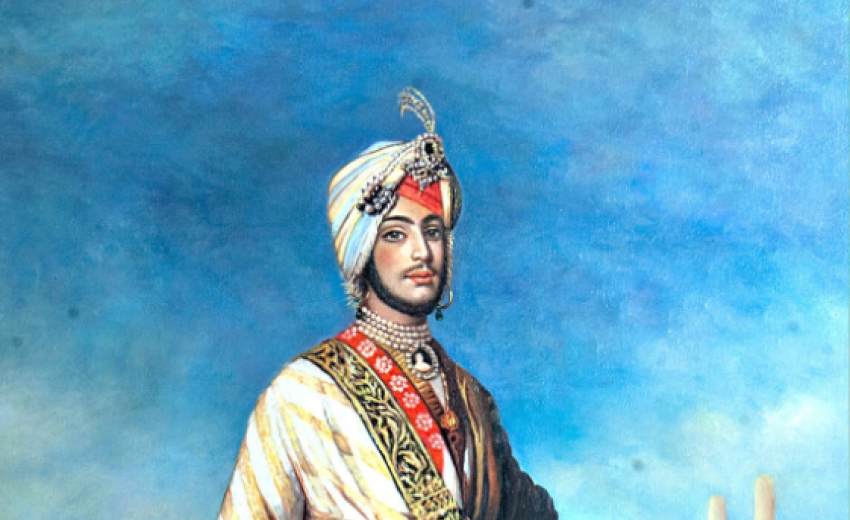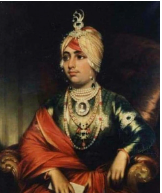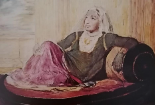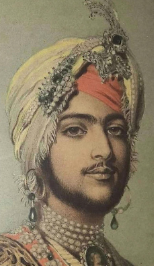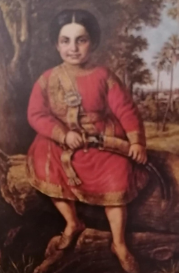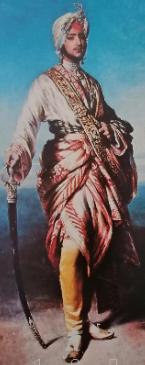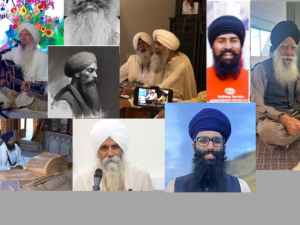Whenever Shere-Punjab Maharaja Ranjit Singh went on a military expedition or to conquer a new territory, he, first of all, would seek Guru Granth Sahib's refuge and support. Whatever victory he achieved, he used to attribute it to Akal Purakh (God's) grace. So much so, when he put his signatures in a "Signature book", he wrote down- Waheguru is helpful- Ranjit Singh,
Royal Feast in the Shalimar Garden:
Maharaja Ranjit Singh's youngest son (Maharaja) Dalip Singh was born on 4th September, 1838. With his birth, Maharaja Ranjit Singh's glory also started fading.
In November 1838, Maharaja Ranjit Singh met Lord Auckland at Ferozepur. Maharaja Ranjit Singh hosted a royal banquet in the Shalimar Garden in his honour. Historians opine that it was at this feast that English officers mixed some poisonous substance in his drink owing to which Maharaja health started deteriorating gradually. While rummaging through the pages of history it becomes quite evident that Prince Dalip Singh did not partake of the "Khanda's Pahul (Consecrated drink or baptismal nectar) when he was living at Lahore. At that time, every Sikh who was expected to take to sms in defence of Sikh pride and power, partook of pahul (consecrated drink) at once. Children of the Sikh families who were committed to take to arms or sword in defence of Sikhism and Sith power, used to partake of "Khanda's Pahul's at an early age. Those of the Sikhs who were not to take part in fighting were not required to partake of Khanda's Pahul right from the days of Guru Gobind Singh. For the sons of the Sikh Rajas (rulers), it was compulsory to take to the sword. Therefore, they used to partake of Khanda's Pahul' at an early age.
Entry of non-Sikh practices:
Although historians make a mention of the observance of traditional Sikh practices by Maharaja Ranjit Singh, yet it was during his time that non-Sikh traditions and practices had started gaining ascendancy. In the Lahore court, there were a series of murders, one after the other. In this upheaval, Maharani Jind Kaur failed in her duty to impart Sikh teaching to her son.
After the establishment of Sikh Raj in Punjab, hundreds of Brahmins kept immigrating here from other states and embracing Sikhism by partaking in Khanda's Pahul'. Historian Alexander writes that during Maharaja Ranjit Singh's rule every year, 5000 persons embraced Sikhism after partaking in 'Khanda's Pahul'.
Dalip Singh Cheated:
The Bhairowal treaty was signed on 16th December, 1846 and in March 1849, the Britishers annexed Punjab. The Christian rulers started preaching their own faith at the cost of Sikhs and Sikhism. The first attack was made after separating Maharani Jind Kaur from her son. How could young, innocent and tender hearted Dalip Singh fathom the pitiable state of his mother?
The second attack was made by taking him away from his motherland. Dr. Logan was made Dalip Singh's guardian and they were sent to Fatehgarh on 21st December, 1849. Only those were sent with Dalip Singh as were tested and tried and about whose faithfulness, there was absolutely no doubt. At first, nobody was prepared to go with young Dalip Singh. At last a Brahmin agreed to go with him. He knew that he would be sent back in six months. Majority of those who agreed to go with Dalip Singh were Muslims. Neither any "Granthi' (Sikh priest) nor a volume of Sri Guru Granth Sahib was sent with the Maharaja. One Brahmin named Bhajan Lal was appointed as his tutor who was an old student of Mission School and was a staunch Christian at heart.
This new tutor did his duty of urging the Maharaja to adopt Christianity. Being a Brahmin, his knowledge about Sikh religion, philosophy, history and traditions and practices was practically nil.
Preparations for sailing to England:
Lord Dalhousie wanted to send Maharaja Dalip Singh to England within two years so that, while in Lahore, he might not entertain an ambition to take back the Sikh Raj. Maharaja was physically kept at a distance from the Sikhs. Lord Dalhousie wanted that he should be separated from his faith and his people. Lord Dalhousie regarded the Maharaja's turban as the biggest obstacle. On 4th August, 1852, Lord Dalhousie instructed George to change the Maharaja's outward appearance of glory (turban). Maharaja had already been betrothed to the daughter of S. Chattar Singh of Attari. Lord Dalhousie wrote to Dr. Logan, "The Maharaja's marriage is the most disturbing factor for us. I do not wish him to be married into a Sikh family." At last they did succeed in their mission. On June 12, 1864, Maharaja Dalip Singh was married to Miss Bamba Mueller, a student of the Mission School.
In this way, the Maharaja contracted a relationship with the Christians as desired by Lord Dalhousie.
Embracing Christianity:
Lord Dalhousie wanted to send Maharaja Dalip Singh to England after converting him to Christianity. He instructed Dr. Logan that on reaching England, the Maharaja should quietly be converted to Christianity, but his name should remain unchanged. The Maharaja started living in the company of his tutor Bhajan Lal (Brahmin) and his Christian friends. Bhajan Lal started teaching him a chapter from the Bible daily. Although the Britishers claim that Maharaja Dalip Singh embraced Christianity voluntarily, it is very difficult to believe that a 12-year old innocent young boy took the decision of becoming a Christian independently. I think that, in order to find out the truth, historians will have to examine the writings of Lord Dalhousie, Henry Lawrence and Sir Dr. Logan carefully. This remains a fact that the Britishers deprived Dalip Singh of education in a good school or university so that his intellect might not develop and grow fully. He was not permitted to meet intellectuals either. He was permitted to meet only Queen Victoria and the royal family. By building a boundary wall around the Maharaja, the English thoroughly exploited him. There is a reference in history that on 8th December, 1850 Mr. Campbell got news through Master Thomas Scott that the Maharaja wanted to become a Christian. When this news reached Lord Dalhousie, he was overjoyed. Bhajan Lal presented a copy of the Bible to the Maharaja. Now the Maharaja had started eating and drinking also with his companions. Although the Maharaja had been living with Europeans and Christians since 1850, yet he had still not given up his Sikh appearance and living style. Though Dalip Singh stuck to his Punjabi eating habits, yet for the first time, it was on the Christmas of 1851 that he took food with Lord Dalhousie and his wife to the same table. It had already been settled with Mr. Cooper that on Christmas day, he (Lord Dalhousie) would take food with the Maharaja.
Maharaja Dalip Singh had beautiful long hair. Then, a time came when he was deprived of his hair. History says that he presented his hair as a gift to Lady Logan. On 8th March, 1853,the Maharaja became a Christian. The change of faith ceremony was performed in a very simple manner, in accordance with Lord Dalhousie's instructions. This ceremony was kept so secret that even neighbours could not have an inkling of it. This ceremony was duly registered. It was signed by Col. Alexander, Lord Logan and Mr. Myse. Maharaja's dear attendant Jawand Singh was also made to sign on this change of religion documents. Many, including Frederick Curry congratulated him.
Reaching England:
Maharaja Dalip Singh was to come of age on 4th September 1854, and Lord Dalhousie was keen to send him to England before that date. The Maharaja too wanted to study at a good school or university in England. When the Maharaja was going to leave for England Lord Dalhousie gifted him a copy of the Bible and said, "This is the best of all the gifts and I have given this gift to my own children also. This is the secret of all joys in this world." The Maharaja left for England on 19th April, 1854 and reached there by the end of May. There he was kept at the Elwin Estate. In England, he was neither admitted to any school or university, nor did he get the company of good people. In England, he received such a cruel and humiliating treatment that after August 1883, he rebelled against the English and the Christians.
Returning to Sikh fold:
Maharaja Dalip Singh now started regarding the English and the Christians as his enemy. He realized the mistake of embracing Christianity at an early age. Although the English succeeded in converting the Maharaja to Christianity in his childhood, yet they did not succeed in alienating him from his glorious heritage. The Maharaja wanted to live among his own people in Punjab and Delhi in the true Sikh form, with a turban on his head. The Maharaja mind kept wandering in the glass palaces of Suman Burj at Lahore Fort, where he had spent wonderful moments of his life. While living in England, he often wished to adorn the walls of his house with the picture of the Lahore Fort. He had not at all forgotten that he was the son of the most powerful Indian Maharaja.
His mother, Maharani Jind Kaur lived with him in England for two years- from 1861 to 1863. During these two years, she acquainted her son with the proud heritage of Sikhs and the Sikhs history to such an extent that he decided to return to the faith of his forefathers. S. Thakur Singh Sandhawalia too visited England in 1884-85 and stayed with Maharaja Dalip Singh for about nine months. He was Maharaja Dalip Singh's cousin also. He read out to him from Sri Guru Granth Sahib and also acquainted him with Sikh history. He put this idea into his mind, "You were a King and shall remain a King." He also assured him that he would make him meet his own people and that the whole of Punjab loved him. He had obtained permission of the High Priests of Sri Darbar Sahib, Amritsar also that Maharaja Dalip Singh could return to the religion of his forefathers. One morning, when Maharaja Dalip Singh got up. he said to Thakur Singh, "Make me a Singh by administering to me 'Khanda's Pahul' (consecrated drink, or baptismal nectar) because at night I had a glimpse of Sri Guru Gobind Singh Sahib who commanded me to become a 'Singh'."
Correspondence with heads of states:
Maharaja Dalip Singh started having correspondence both with the countrymen and the Sikhs. The substance of all these letters was: "I have returned to the religious faith of my forefathers (i,e Sikhism) and shall partake of Khanda's Pahul' soon." His complete faith in the Satguru also finds expression in this correspondence. Pardon too was sought from the Khalsa. In one such letter, there is mention of partaking of 'Khandas's Pahul." Such letters were received by S. Sant Singh, Bhai Gurmukh Singh, professor, Oriental College, Lahore etc. News stories to this effect appeared in the Tribune of Lahore dated 17th April, 1886.
Partaking 'Khanda's Pahul' in Aden:
On 21st April, 1886, Maharaja Dalip Singh, alongwith his family, reached Aden. S. Thankur Singh along with another Singh had already reached there. When Maharaja Dalip Singh came to know to S. Thakur Singh's presence, he got ready to partake of 'Khanda's Pahul.' But the British Resident did not let the two meet each other. At last when the Maharaja sent an application to the Governor General, he was granted permission. The government did not want to interfere in a religious affair because in 1858, Queen Victoria had declared complete religious freedom. But the government viewed every action of the Maharaja from a political stand-point. In 1883, the govt. had not permitted the offerings made by the Maharaja [through his purohit (priest) to be sent to India.
'Ardas' (Prayer) at Sri Akal Takhat Sahib:
When the Governor General was fully convinced that it was only a religious ceremony, he the offerings for Sri Akal Takhat, Darbar Sahib, Amritsar, and the 'Samadhs' (shrine raised over the ashes of a deceased person) of Maharaja Ranjit Singh and Maharaja Mahan Singh (at Lahore and Gujranwala) to be sent to India. The following 'ardas' (prayer) was offered at Sri Akal Takhat Sahib. but could be brought only from Bombay." The Maya(Money) has been sent by Maharaja Dalip Singh for "Karah Prasad'. May Waheguru bless him with good health and Sikhi!" This news sent a wave of joy among the Sikhs. Rumours became rife in Punjab. The secret political report sent to the government on 24th April, 1886 said that Baba Khem Singh (Rawalipindi) and Baba Sujan Singh Una (Hoshiarpur) would attend the ceremony of partaking of 'Khanda's Pahul' by the Maharaja. Many of the Sikhs in Punjab were quite active in finding out where the ceremony would be held at Amritsar, Abchal Nagar or Anandpur Sahib. Many of them wanted to be present on this occasion. Ferozepur Sikhs said that the Maharaja would come to Amritsar. All this was mentioned in the secret report.
Partaking of 'Khanda's Pahul':
It was at Aden that Maharaja Dalip Singh partook of 'Khanda's Pahul on 25th May 1886 and became a 'Singh'. On this occasion, S. Thakur Singh and his fellow Singh played an important role. Along with him were also present S. Roor Singh Jat, Kuhali (Amritsar) and S.Jawand Singh Rurki (Lahore). Services of two other Singhs were also utilized for performing this ceremony. They had reached Aden in a cargo ship. The British Resident kept himself away from this ceremony and did not create any hurdles in the ceremony of administering 'Khanda's Pahul' to Maharaja Dalip Singh by the Five Singhs. After becoming a duly baptised Singh, his normal needs also increased.
Maharaja Dalip Singh gave a memorandum to the British Resident in which he detailed his needs-one Sikh Priest (granthi), a sewadar (attendant) for the volume of Sri Guru Granth Sahib, two cooks, two bearers for serving tea, food etc. three washermen, one tailor, one sweeper and eight riflemen. The Resident felt that the tailor, washerman and sweeper could be recruited locally, but all others could be brought only from Bombay. The government had also to take this decision as to whether or not a granthi Singh (Sikh Priest) and sewadar (attendant) for Sri Guru Granth Sahib were to be provided to the Maharaja. The government was of the view that the recruitment of a granthi (priest) and Sewadar (attendant) was the personal affair of the Maharaja. He could employ Sikhs of his liking but they could not go anywhere without the permission of the government. The govt. was not willing to allow the Maharaja to stay at Aden for a longer period. It wanted to dispatch him quickly either to England or Egypt. Maharaja's conscience did not allow him to go back to England. Therefore, he decided to go to France.
Maharaja Dalip Singh kept his headquarters in Paris and he renounced his British citizenship. On 10th January, 1887 in Pondicherry, Maharaja Dalip Singh announced the setting up of his govt. in exile. S. Thakur Singh was made its Prime Minister. Thereafter, S. Thakur Singh, leaving behind his family and a confidant, successfully reached Pondicherry from where he could remain in touch with the Maharaja. At that time, Pondicherry was a colony of France and did not come under British rule. The British Govt. regarded S. Thakur Singh's contact with the Maharaja as dangerous. Lord Cross, Secretary of State for India instructed India's Viceroy Lord Dufferin to keep a strict watch on the Sandhawalia Sardar. In his letter of March 9, 1887, he wrote," I am not worried about Dalip Singh. We are keeping a close watch over his activities to the extent possible, but I do not regard the man in Pondicherry as good. We cannot stop him from meeting Dalip Singh, if he so desires". From Paris, Maharaja Dalip Singh issued many significant proclamations regarding his coronation.
Travel to Russia:
Maharaja Dalip Singh's partaking of 'Khanda's Pahul' sent a wave of joy among the Sikhs. Every Sikh living in Punjab regarded the Maharaja as a true Sikh and owing to Guru Gobind Singh's prophecy, they had started considering Maharaja Dalip Singh as the true leader. For the fulfilment of his mission, the Maharaja went to Russia on 18th September, 1887. The Maharaja lived there (in Russia) for one year and eight months. But he did not succeed in his mission there because his two special friends Mr. Metcaulf and S. Thakur Singh Sandhawalia had passed away during this period. The Maharaja wanted to enter Punjab via Russia but this plan did not materialise. At last the Maharaja returned to Geneva from where he wrote several letters to the Sikhs and his countrymen in which he made mention of Guru Gobind Singh's prophecy. Maharaja Dalip Singh believed that according to the Tenth Guru's prophecy, the rule of truth would be re-established. In the application, he presented to the Czar of Russia, he affirmed his claim over Punjab. In Russia's Department of Ancient Manuscripts, many important documents of Maharaja Dalip Singh are still lying safe and secure.
Final Resting-place:
While engaged in this struggle, at last, Maharaja Dalip Singh fell ill. Owing to paralysis, his health worsened day by day. Finally on 23rd October, 1893, he died at the Great Hotel, in Paris. He was a Sikh by birth and he died as a Singh. Like an orphan, he went to eternal sleep in an alien land. He did not get a piece of land in his own country. His son buried him in the Church courtyard beside the graves of other members of the family. The Tribune of Lahore wrote: "Our Dalip Singh, your country can only lament your passing away."
